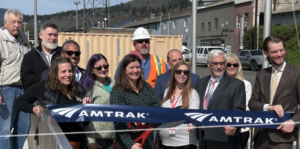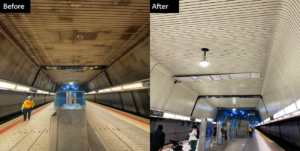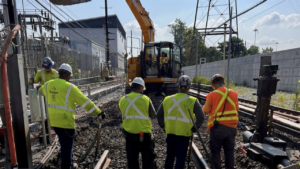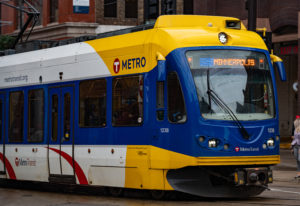Strong and helpful hand-held tools
Written by Jenifer Nunez, assistant editor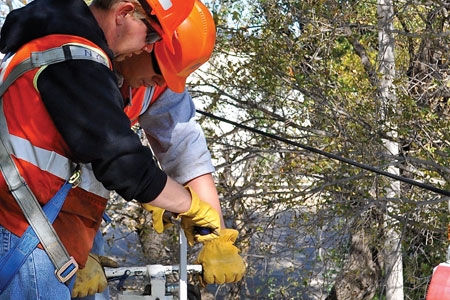
Notable jobs sometimes require the smallest of tools. Suppliers are offering up big improvements for these hand-held devices in 2013.
{besps}December13_hht{/besps}{besps_c}0|1hht.jpg| PortaCo’s stand up lag driver in use.{/besps_c}{besps_c}0|2hht.jpg| Amsted’s E-Z Wrench Spring Anchor Applicator, which is used for applying all types of spring anchors.{/besps_c}{besps_c}0|3hht.jpg| ERICO’s control unit and the CADWELD PLUS system.{/besps_c}{besps_c}0|4hht.jpg| Left, a Railtech Matweld, Inc., Track Rover on a rough terrain track rehabilitation project.{/besps_c}{besps_c}0|5hht.jpg| Stanley Hydraulic Tool’s HP28 Twin Circuit Power Unit.{/besps_c}
Notable jobs sometimes require the smallest of tools. Suppliers are offering up big improvements for these hand-held devices in 2013.
Small tools for the maintenance of track, whether it’s freight or passenger, are of great importance to railroads. They may be small, but they tackle the largest of problems across North American lines and help to keep people and products safe during transit.
Amsted RPS
2013 was an exciting year for Amsted RPS with much growth in its core rail fastening business. Amsted RPS expanded production of its SL Series (U2000 and 6030LR) of fasteners at its Atchison, Kan., plant, introduced a joint venture with Switzerland-based Schwihag AG, by manufacturing “skl” style rail fastening systems, evolved the MACRO Armor line over the past two years and partnered with the edilon)(sedra, a Netherlands company known for vibration reducing products.
In addition to its existing line of hand tools for rail anchors and SL Series of fasteners, Amsted RPS will add a number of tools in support of its expanded product line including a T-Wrench and Dowel Extraction Tool for maintenance of the ME63 (skl) System, a MACRO Armor Plate Placement tool used to position the MACRO Armor Repair Plate during the restoration of abraded concrete ties and, finally, Amsted RPS has introduced the Custom Mixer used with the edilon)(sedra Corkelast for embedded rail applications to increase the quality and productivity of installation crews.
“The Amsted RPS line of hand tools supports the growing product line with a focus on safety and productivity,” said John Stout, director of sales. “These tools are designed to be lightweight, with most weighing less than 25 pounds, but tough enough to make installations in a demanding railroad environment. The Amsted RPS E-Z Wrench, for example, is engineered for convenience with the end-user in mind. A unique three-piece mechanical advantage design transfers the most power with the least effort, by more than four times the amount of applied force.”
Safety is always a top priority at Amsted RPS, Stout says. In addition to the standard line of hand tools, Amsted RPS also develops custom designs to meet the unique needs of customers. Each new design is rigorously tested in the lab located in Atchison, Kan., followed by field trials to reach an optimum combination of performance and durability, the company notes.
“As loads get heavier and traffic continues to increase, we do our best to listen to our customers and let them steer our product development initiative,” explained Stout. “It is clear that the railroads need high quality fastening systems that last for the life of the rail to minimize maintenance and maximize track utilization. With that, our selection of hand tools are specifically designed to make installation faster and more consistent, improving safety and reducing maintenance down time. New tool design can be created based on the specific application and need.”
Cembre
Cembre Inc. introduced the RoboKatta Automatic Rail Saw in the first quarter of 2013 and the company says that so far, the feedback has been very positive with transits and Class 1 railroads across America.
“We have also added to our tie drilling range with the Cembre SD-15PR-ECO Tie Drill that includes a forward and reverse feature, allowing for easy drilling and safe removal of drill bits in the event of jamming,” noted Chris Drew, vice president of sales at Cembre. “Along with the CS-SD support trolley, the SD-15PR-ECO and NR-11P Impact Wrench can now be fitted with extensions for drilling or lagging of timber guard rails up to 43 inches from field side for bridge applications.”
ERICO
As an improvement to ERICO’s CADWELD PLUS exothermic welding line, the company developed a hand-held control unit to initiate the CADWELD Rail Power or Signal Bond track connection.
“The electronic control unit means no starting material is required, making installation quicker and easier,” explained Matt Caie, director of ERICO rail connection sales. “The control until has a six-foot or 15-foot lead to get to hard to reach installations and promote user safety.”
He says that it has been a good year for ERICO, with a lot of activity in the industry and is looking for that to continue in 2014.
“Demand is being driven from a number of areas and reasons, not only transit but in the main railways also,” Caie said.
Hougen
Trak-Star®, a division of Hougen Manufacturing, has introduced a number of new products and modifications to existing products in recent years.
Trak-Star has introduced a Gas Powered Impact Wrench with 1250 ft./lbs. of torque. In addition, Trak-Star also carries OZAT socket and 18-inch auger bits to accompany the impact wrench.
The company released its 16-inch Hydraulic Rail Saw. Operating at 10 GPM, Hougen notes the saw produces approximately 10 percent more revolutions per minute than most hydraulic saws in the industry, allowing for faster rail cuts while reducing blade glazing. The rotation is fully reversible, allowing for cutting from either side of the rail without dismounting. Just a quick step over and flip of the saw is all that is required, the company says.
Due to increased demand, Trak-Star has standardized the offering of equipment for drilling crane rail and girder rail. Most items are in stock, allowing for quick response to urgent demands.
“Trak-Star has been known throughout the fabricating industry for many years for offering safe, lightweight, magnetic drills,” noted Brian Buys, technical sales representative. “Now, three models are available through the Trak-Star line for drilling; steel ties, switch plates, bridge fabrication and maintenance, car repairs, locomotive repairs and any other application that involves drilling steel plates. The magnetic drills MD40, MD50 and MD70 have capacities ranging from 1-3/8-inch diameter through one-inch depth of cut to 2-1/16-inch diameter through three-inch depth of cut.Thesedrills are all designed to shut off if the magnet lifts from the cutting surface.”
Buys says that business has been holding steady for 2013 and notes that hopefully optimism will show an increase in 2014. He says that transit business via contractors and rail contractors have shown an increase.
“Trak-Star always incorporates safety and ergonomics into every product it manufactures and sells,” Buys said. “Rigorous testing is done and specific injury problems are identified and corrected prior to any marketing of any product.”
Modern Track Machinery
Modern Track Machinery, Inc. (MTM), is releasing a new lightweight gasoline tamper in early 2014.
“We believe that there is a market for a gasoline-powered tool that is equal or less weight than the hydraulic-powered versions and about half the weight of other gasoline- powered tampers currently on the market,” explained Alan Reynolds, general sales manager.
Reynolds says that safety is paramount in driving new products and that the railroads are continually looking for suppliers to develop ergonomic, lighter tools, with safety in mind, for their employees.
“We feel the industry as a whole is strong with all segments contributing to growth,” he noted and said that MTM is cautiously optimistic that 2014 will be a good year.
PortaCo
PortaCo, Inc., introduced a new dead head spike driver, tie drill and stand up lag driver. The company notes that the dead head spike driver does not require a worker to hold a hand tool while it is being driven by another worker swinging a heavy hammer and that it automatically stops when the trigger is released.
“Our business is very strong,” explained Robert Mueller-Reinwarth, vice president operations. “We have recently joined the Goldschmidt Thermit Group, which now gives us a global presence. This allows us to add distribution on a worldwide basis, selling through the other 22 companies that make up the group. We have also strengthened our North American presence by working closely with Orgo-Thermit, which is also part of our new group. We are already seeing a large increase in our current business and are very excited about the upcoming year.”
Safety is the most important feature of all of PortaCo’s products, Mueller-Reinwarth notes and says that many of its tools allow the worker’s hands and face to be at some distance from the cutting, grinding or other activities, by having a long handle designed into the tool.
“All of our tools route the hot hydraulic fluid away from the area where the tool is being held in the operator’s hand, reducing the chances for burns,” he said. “Our tools are designed to operate at lower and safer pressures, minimizing the danger. Our ergonomically-designed tools meet the market demands for easier to use and safer tools; most of our tools allow the worker to stand up while using them.”
Racine Railroad Products
Racine Railroad Products, Inc., has made modifications to improve performance to its hydraulic spike puller and will be introducing a new hydraulic spike driver, hydraulic rail saw and gas drill in2014.
These new tools are designed to improve performance, ergonomics and offer more operator-friendly features, the company notes.
“Hand-held tool sales have been lower than the forecast projection for 2013,” explained Stephen Birkholz, president. “We are optimistic for sales to grow in 2014 from the new product line offerings.”
He points to safety features as the number one design criteria consideration for hand-held tool improvements.
“Customers are always looking for tools that are lighter in weight, ergonomically easy to use and at a lower operating cost,” Birkholz said. “Transit industry customers have a special interest in battery-powered options for work in tunnels and underground structures. Sales to the contractors, shortline railroads, Class 1s and transits have been balanced this year.”
Racine moved to a larger, modern facility in 2013 that will allow it to offer customers a wider range of products, Birkholz notes.
Railtech Matweld
Railtech Matweld, Inc., developed a hydraulic-powered four-wheel-drive mobile work cart called the Track Rover, which was traditionally only available in a gasoline-powered version but is now available in diesel. Operator control is remote via a hand-held radio transmitter, which keeps the operator at a safe clearance when maneuvering through rough terrain or over rail, the company notes.
“The Track Rover is equipped with a hydraulic tool circuit; this mobile power source can be customized for the tough tasks and multiple jobs the railroad environment demands,” said Alex Hellkamp, vice president sales and marketing at Railtech Matweld, Inc. “From either equipping the Track Rover with complete welding materials to go on location, new construction material hauling and having all the associated tools equipped, derailment responder or a complete rail yard working team deployment set up, the Track Rover can suit the tough demands of the railroad environment.”
When railroads purchase equipment, safety, quality, cost and support after the sale are all considerations taken into account, Hellkamp notes and says the ability to work together safely is paramount in this fast-paced industry.
“With the loss of so much of this industry’s seasoned talent to retirement, customers and suppliers will need to continue more than ever to communicate safety, training and product support,” he explained.
As an ISO certified company, Hellkamp says Railtech Matweld strives to build the best products for the railroad industry and offer complete support after the sale by its team.
“Not only do we have direct factory support, but also one of the best and well-respected sales staff with ESCO Equipment Service Company representing and supporting our products,” said Hellkamp.
Stanley Hydraulic Tools
Stanley Hydraulic Tools has launched its Twin 8 power pump for the railroad industry. The Twin 8 Power Pump offers more versatility than comparable units in the field, Stanley notes and says the pump is capable of powering two hydraulic tools simultaneously at eight gallons per minute (GPM), offering more productivity and lower operating costs by getting the work completed more rapidly.
Stanley’s Active Thermal Management (ATM) is designed to ensure that the power pump maintains optimal oil temperature in the most extreme conditions. Ease of transport and positioning is done at a variety of lifting points and a control panel offers ease of use and good visibility while the unit is functioning minimizing operator’s time, the company says.
Stanley has also launched a new interlock trigger for the SPL31 Spike Puller.
“This new feature offers added defense with a secondary trigger, reducing unintended operation when the tool is placed on the ground while connected to hydraulics,” explained Aaron Sztuk, global product manager. “The interlock feature is incorporated on the handlebar and can be operated seamlessly with little effort, ensuring the operator maintains safety and efficiency on the job-site.”
Fiscal 2013 remains strong with several new product development launches on the horizon for 2014; the company notes the focus continues to expand the product portfolio and technology to the rail industry. Stanley Hydraulics will continue to work closely with its customers to advance safety and productivity.
Stanley has a field sales force that works closely with its railroad customers. Beyond the standard product and safety training seminar conducted in the field, Stanley is constantly on the hunt to improve operator safety.
“Using ‘voice of the customer’ techniques and surveys, we integrate that input and leverage new technologies to increase operator safety,” said Sztuk. “Outside the typical macro drivers of heavy investment in infrastructure, market demand for increased operator safety, lower fatigue rate and dependable tools drives Stanley to engineer more proficient tools to lower operating costs on the job site.”


